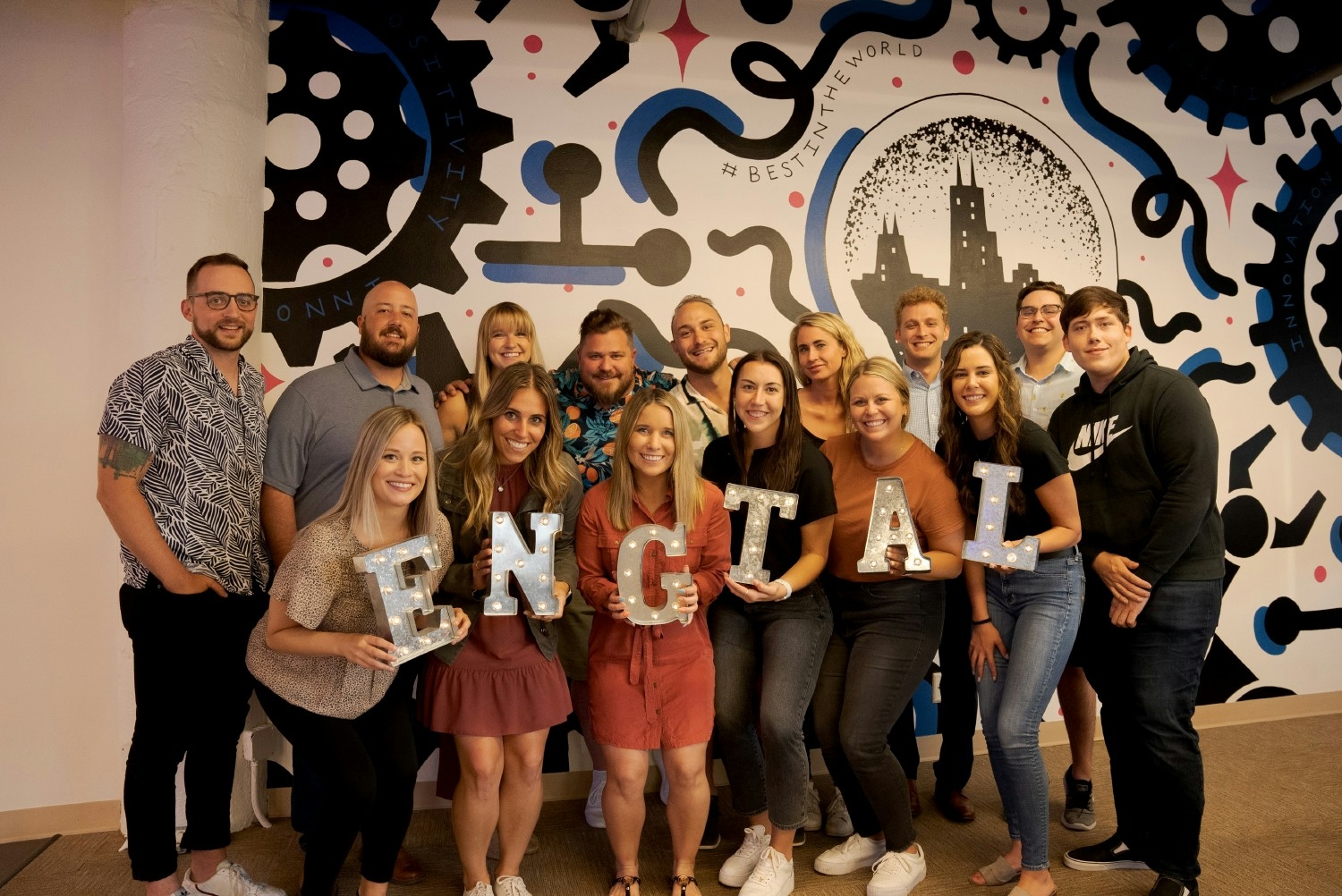
Employee recognition has long been a cornerstone of effective management. But today, as the competition for talent escalates, the ways organizations show that they value their employees have become more important than ever.
Creating a recognition program is a start—so if you don’t have one, that’s a good first step!—but great companies go further, constantly reevaluating the ways they reward employees. As companies grow, this becomes even more of a challenge, and leaders must rethink the way they add value to the employee recognition experience.
What is employee recognition?
Employee recognition refers to all the ways an organization shows its appreciation for employees’ contributions. It can take many forms and may or may not involve monetary compensation. Companies recognize employees for things like:
- Achievements
- Exhibiting desired behaviors
- Going above and beyond expectations
- Milestones such as tenure
Why employee recognition matters
From a very early age, we crave recognition from parents, teachers and friends. So strong is our desire for positive affirmation, particularly during developmental periods, that we can even perceive a neutral reaction as a negative one.
This continues to hold true as we move into the workplace. Employee recognition helps to:
- Retain top talent
- Increase employee engagement
- Encourage high performance
Great Place to Work-Certified™ company O.C. Tanner studied employee engagement and how managers can tailor their workplaces to promote it.
An employee survey included the question, "What is the most important thing that your manager or company currently does that would cause you to produce great work?"
Respondents answered in their own words, providing a variety of responses, but a clear pattern emerged. 37% of respondents said that more personal recognition would encourage them to produce better work more often.
While other themes like autonomy and inspiration surfaced, recognition was the most common theme that emerged from responses. The study showed that affirmation, feedback and reward are most effective for motivating employees to do their best work.
See the complete results in the chart below:
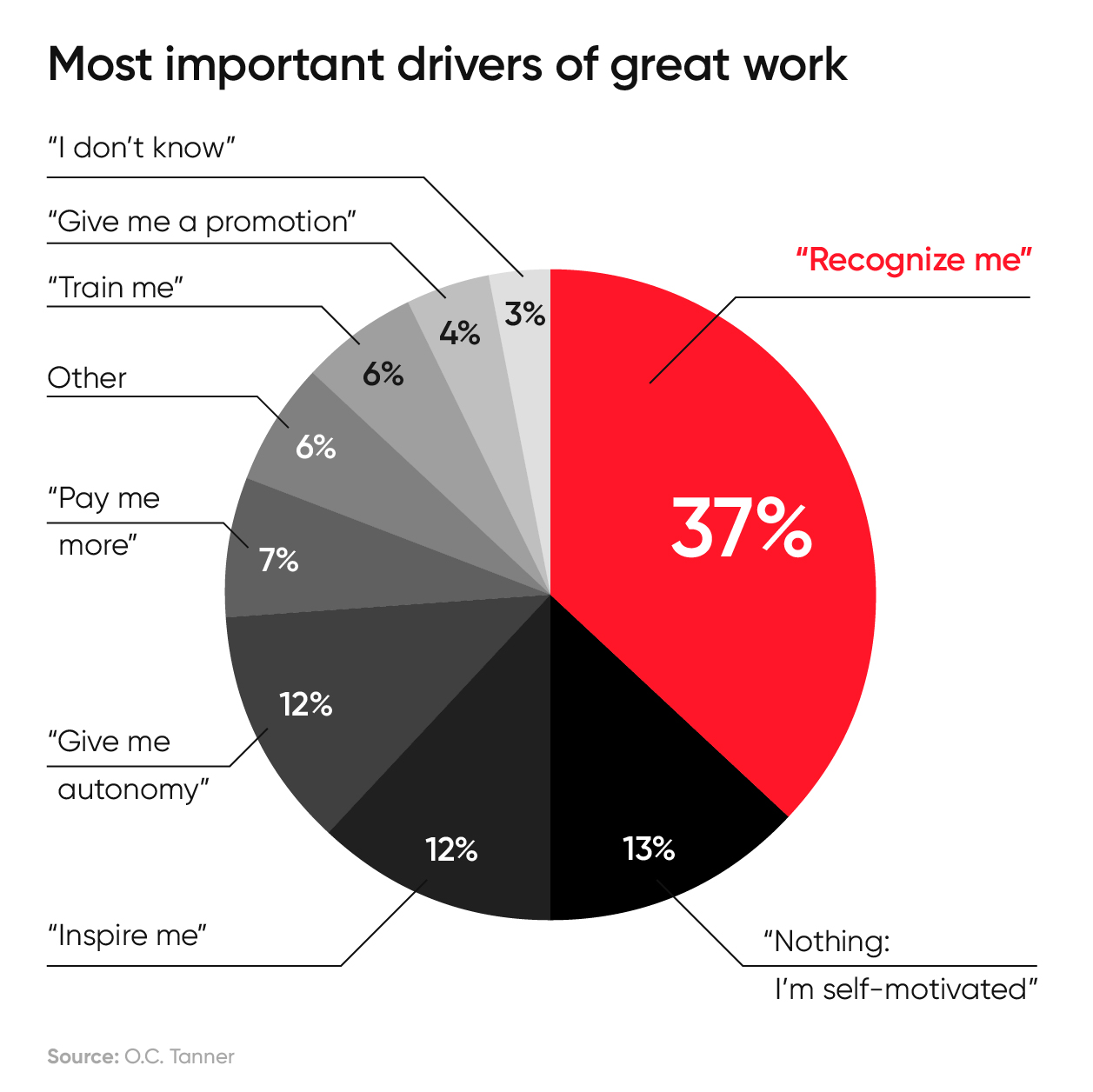
By narrowing in on several statements in Great Place to Work® Trust Index™ survey that measure how much employees feel recognized at work, we were able to see the impact of recognition culture on employee experience.
Great Place to Work analyzed 1.7 million employee survey responses gathered between 2018 and 2020 across small, mid-sized and large companies.
Recognition makes employees feel promotions are fair, spurs innovation and extra effort
After comparing the overall experience of employees who received recognition to those who don’t, we found that recognition was strongly tied to several areas of positive company culture.
Compared to those who do not consistently feel recognized at work, people who do feel recognized at work are:
- 2.6x more likely to think that promotions are fair
- 2.2x more likely to say innovative thinking is embraced
- 2.0x more likely to say people here are willing to go above and beyond
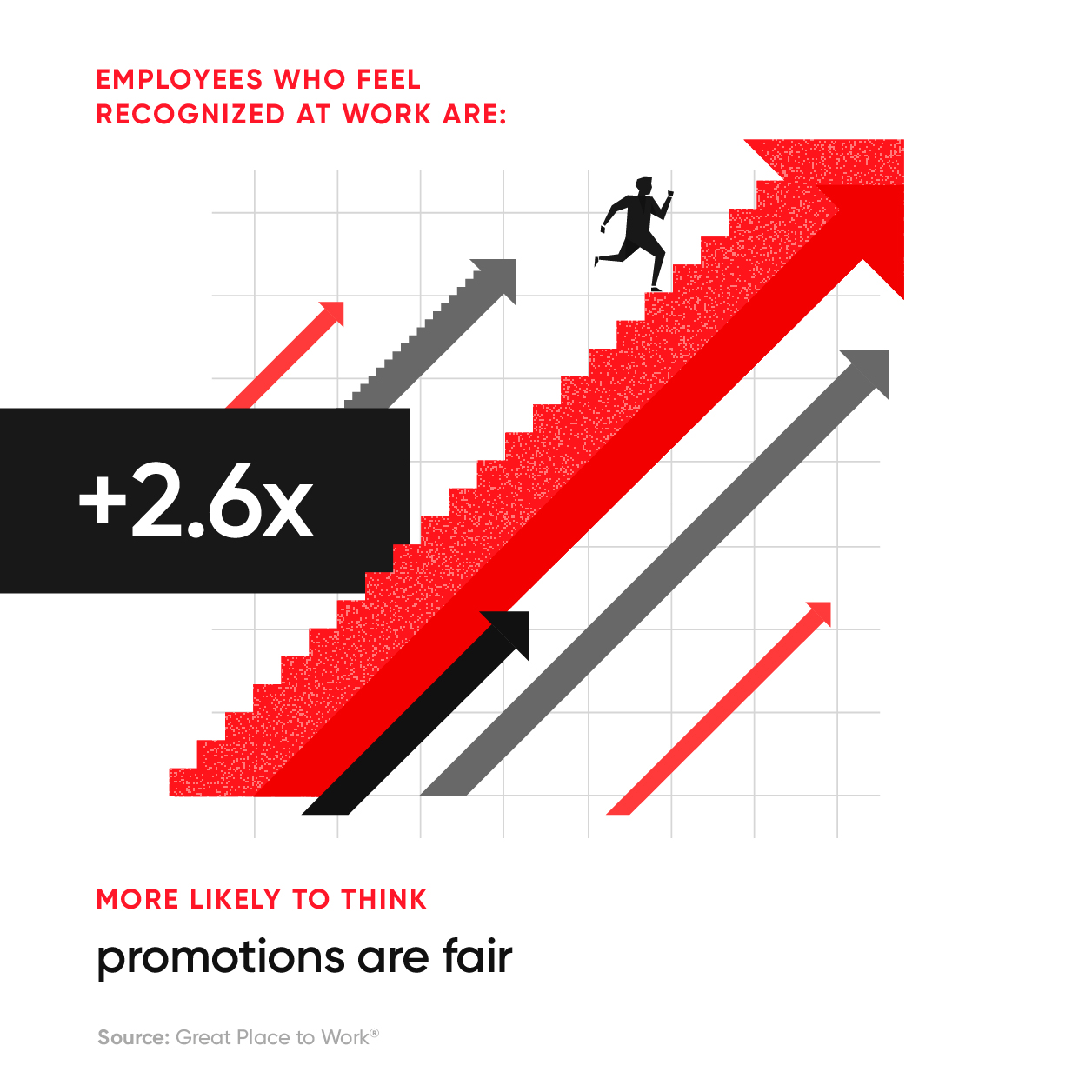
Employee appreciation is linked to higher job satisfaction
In the same Trust Index™ survey, when asked what makes their workplace “great,” employees who responded positively to survey questions measuring recognition say that they are “incredibly lucky,” “enjoy hanging” and that the company has “excellent integrity,” “uplifting environment” and some mentioned their “career success.”
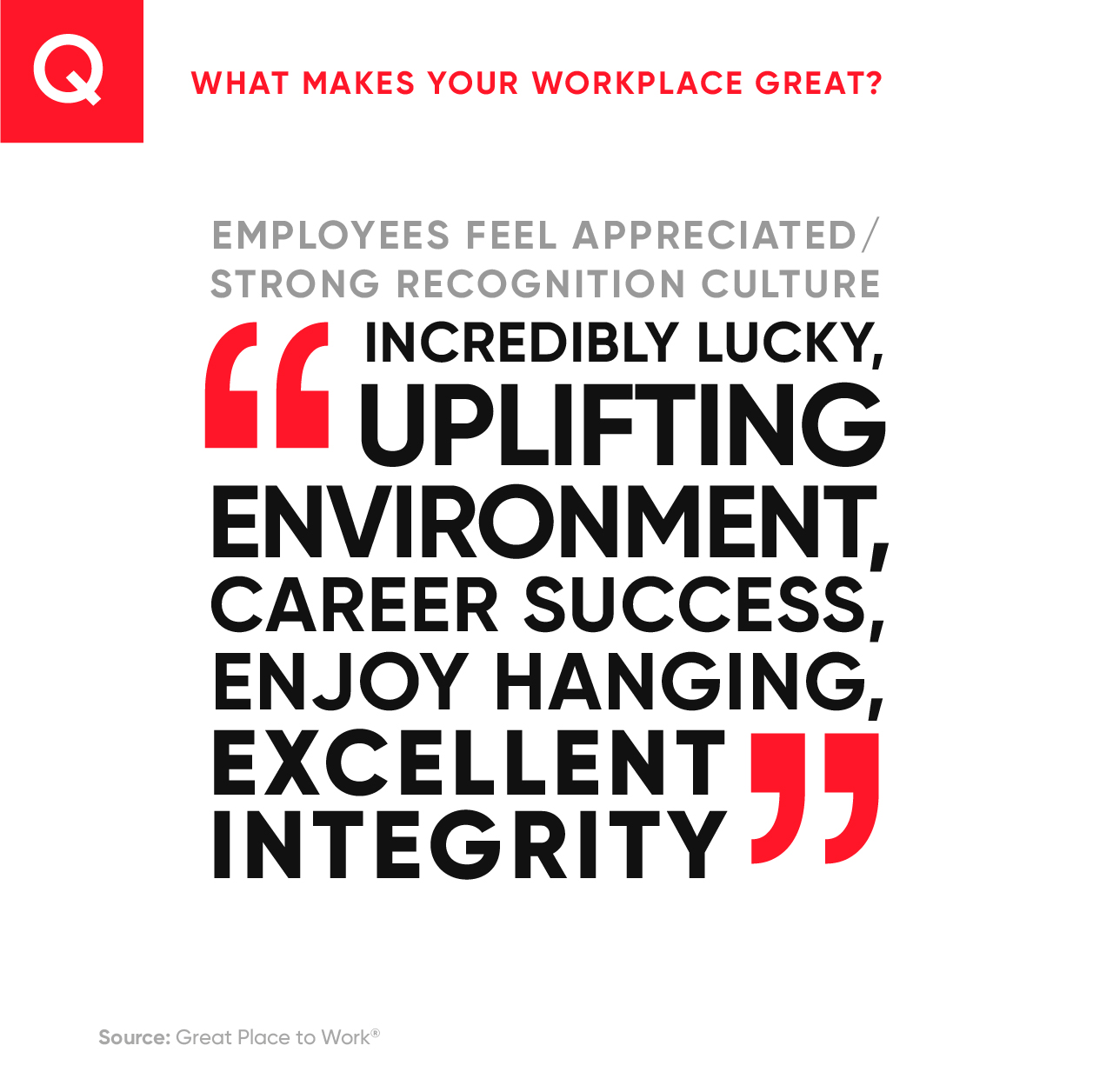
Employees who don’t feel recognized also struggle to describe what makes their workplace great
Conversely, employees who don’t feel recognized at work responded to the same question with phrases such as “plays favoritism” and “popularity contest,” indicating there isn’t much that makes their workplace great. The only positive theme was “match benefits.”
When asked what would make their company better, the employees who felt unrecognized responded with phrases that indicated feelings of unfair treatment and a manipulative work environment. Words such as “rampant favoritism,” “scare tactics,” “stop eliminating” and “job tomorrow” were most common among the “unrecognized” group.
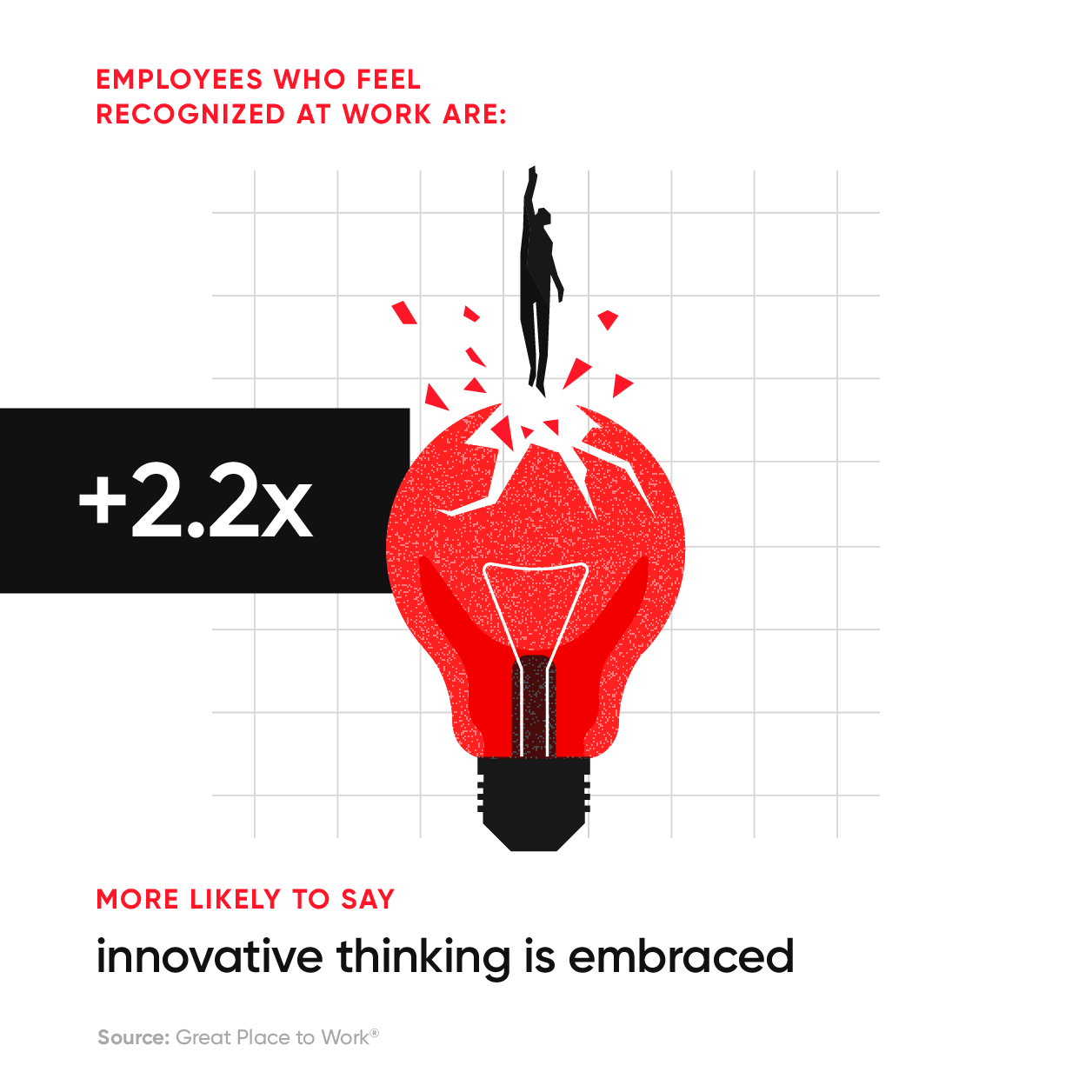
How to create a meaningful employee recognition culture
Many Great Place to Work® clients, even those with strong company cultures, face challenges when it comes to team and individual employee recognition.
While there is no universal program for every organization, there are five key elements of meaningful employee recognition that all managers can use.
Creating a culture of recognition: 5 keys to meaningful employee recognition programs
1. Be specific, be relevant
Recognition is more meaningful when it is tied to a specific accomplishment or business objective.
When recognizing employees, explaining what the recognition is for helps employees relate the recognition to their behavior. This encourages continued strong performance.
2. Be timely
Recognition that arrives months after the fact isn’t nearly as meaningful as recognition received promptly.
The longer it takes for managers to recognize employees, the less likely employees will see the affirmations as authentic. Make employee recognition a priority and have formal recognition systems in place so you can strike while the iron is hot.
3. Recognition comes in many shapes and sizes
There is a great deal of research that indicates people are motivated by more than just cold hard cash. It is also important to note that everyone has their own preference or style when it comes to giving and receiving appreciation.
Get a clearer picture of the primary language of appreciation (in a work setting) of every individual. Then, recognize them accordingly.
Beyond a bonus or a raise, consider customized gifts, taking them out for dinner or other acts that show employees their reward is personalized to them.
4. Little things go a long way
While it's crucial to recognize major accomplishments, don’t overlook the power of the everyday thank-you to motivate employees.
Writing handwritten notes, or using the intranet to promote the good behaviors of individuals, can help instill a regular culture of employee recognition. These thank-yous and shout-outs don’t have to come from managers alone; some employees may find recognition more motivating when it comes from their peers rather than from leadership.
5. Connect to the bigger picture
Recognition helps employees see that their company values them and their contributions to the success of their team and the company overall.
This is particularly key when organizations grow or change. It helps employees build a sense of security in their value to the company, motivating them to continue great work.
Regularly share news about how the company is striving to reach the mission, and explain how individual employee goals relate to that vision.
Organizations on the Fortune 100 Best Companies to Work For® list excel in employee recognition.
Here are some examples of how these winning organizations recognize and reward their employees in meaningful ways:
Examples of employee recognition
1. Make it easy for managers to celebrate employees
Global hotel chain Hilton provides managers an annual Recognition Calendar that features 365 no- and low-cost, easy-to-implement ideas for thanking employees.
The calendar includes reminders and tips for enterprise-wide, brand and department recognition programs; appreciation best practices; important dates like International Housekeeping Week; and recognition quotes to share with employees.
It also allows users to add employee service anniversaries and local events. Users can download a print-friendly PDF or import an Outlook-friendly file into their personal calendars.
2. Make recognition a red-alert event
When clients of professional services firm Crowe respond to a satisfaction survey with the names of individuals who have gone above and beyond during projects, the survey generates a "Recognize Alert."
Crowe takes Recognize Alerts one step further with its Pay It Forward program. Individuals who were recognized can "pay it forward" to other colleagues who played important roles in serving clients but weren't mentioned in the survey response.
Crowe shares the names of both Recognize Alert and Pay It Forward recipients in Crowe Newswire On Demand so others can learn from their examples and the individuals feel appreciated.
3. Meaningful gestures of gratitude
Health care system Texas Health Resources recognizes employees' milestone years of service at five-year increments.
At every milestone, honorees receive a beautiful customized celebratory yearbook. Each yearbook opens with a personalized congratulatory message of appreciation from the CEO. Inside, the honoree finds messages of thanks and appreciation from their manager and coworkers, as well as photos of the employee at work with their team, having fun and contributing to the mission.
Recognition is absolutely essential in a great workplace, and it doesn't need to be complicated or expensive.
Ask your employees what type of recognition is most meaningful to them. You may be surprised to find how much simple, genuine expressions of thankfulness inspire them to do their best.
Do you know if your employees feel appreciated?
We designed an employee survey – based on 30+ years of studying employee experience – to measure and track levels of employee recognition, trust, innovation, and more. Contact us about it today.






